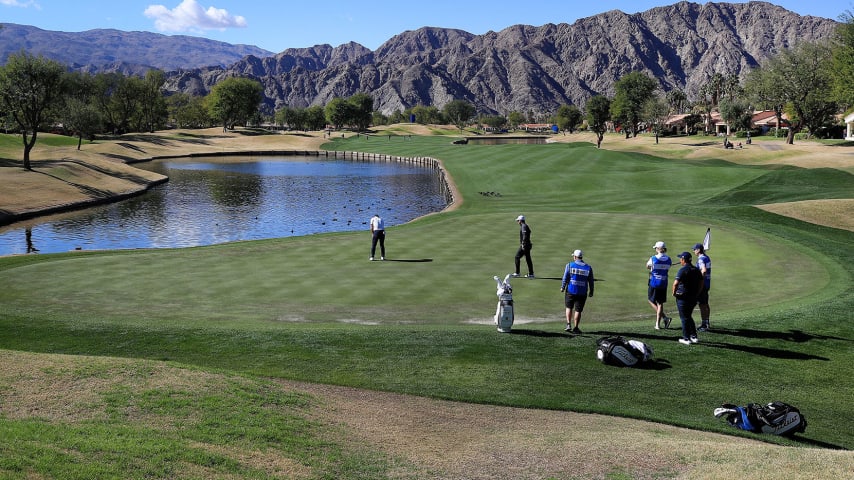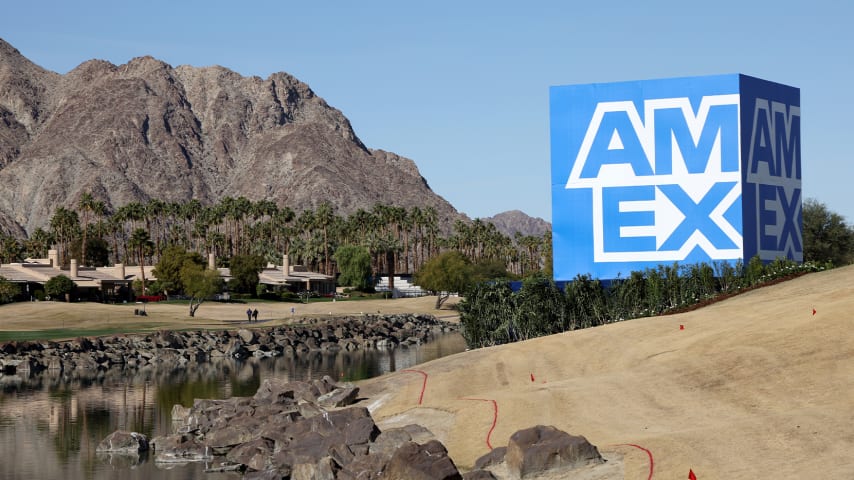Five things to know: PGA West’s Stadium Course
8 Min Read

LA QUINTA, CALIFORNIA - JANUARY 24: Paul Casey of England putts on the fifth hole during the final round of The American Express tournament on the Stadium course at PGA West on January 24, 2021 in La Quinta, California. (Photo by Sean M. Haffey/Getty Images)
Written by Sean Martin
The host venue for this week’s The American Express is one of the most unique on the PGA TOUR. PGA West’s Stadium Course was built by a World Golf Hall of Famer who added a California ethos to his groundbreaking style when he built this course out of the desert. Like its predecessor, the second Stadium Course also had a controversial debut. It was so hard when it was played 35 years ago that TOUR players petitioned to have it removed from the schedule.
PGA West’s Stadium Course may not be as intimidating as it once was, but Dye’s trademark tricks still promote drama, especially on the course’s closing holes.
“We’re just giving (the pros) the opportunities to hit great golf shots,” Dye once said. He viewed his penal designs as a canvas for the world’s best players to truly display their skills.
The Stadium is one of three courses in use this week but the only one that will be played multiple times, including in Sunday’s final round.
Here are 5 Things to Know about the Stadium Course at PGA West.
1. ‘THE HARDEST DAMN COURSE’
Dye was given simple instructions when tasked with building the Stadium Course at PGA West.
“Build the hardest damn golf course in the world,” developers Ernie Vossler and Joe Walser told him.
Dye had already shaped TPC Sawgrass’ Stadium Course out of a Florida swamp, earning him a reputation as an iconoclastic architect who built demanding layouts that required pinpoint precision. TPC Sawgrass debuted as the venue for THE PLAYERS in 1982, and its difficulty drove players mad. A short time later, Vossler and Walser asked Dye to enact a similar transformation on the opposite coast, creating another stadium design in the desert of California’s Coachella Valley.
Dye accomplished his mission. PGA West’s Stadium Course was deemed the hardest in the nation when it opened. Its course rating of 77.1 was the highest ever given by the United States Golf Association. This reputation earned the Stadium Course the 1991 Ryder Cup, though that competition was later moved to another Dye design, Kiawah Island in South Carolina, because of concerns about hosting an intercontinental competition in the Pacific Time Zone.
2. TRANSFORMATION IN THE DESERT
The Stadium Course is famous for its dramatic features, including steep slopes and penal hazards. The course belies the property’s original state as a flat parcel of desert. Dye wrote in his autobiography that the “featureless, barren acreage” was the “worst piece of land we ever started with.”
The sandy soil allowed Dye to mold a memorable course from the ground. Working in the desert was like playing in a giant sandbox. Dye sculpted a course where water comes into play on nearly half the holes, and there’s more square footage of sand than putting surface.
“Length alone would not be the ultimate test for the new course, but I believed strategic hazards, deep bunkers, difficult angles across fairways, slightly offset greens, parallel lakes and desert plants, when combined with cross-current winds, could provide the type of course Joe and Ernie expected,” Dye wrote in his autobiography.
3. THE REVOLT
The Stadium Course’s debut as a TOUR venue in 1987 proved that Dye had done his job.
Raymond Floyd called the course “spiteful” and “hateful.” Tom Watson said he was “sick and tired” of Dye’s radical designs.
“It requires you to execute shots that no sane golfer should be expected to play,” Watson added.
Famed Los Angeles Times columnist Jim Murray wrote that “you need a camel, a canoe, a priest and a tourniquet to get through it.” California native Al Geiberger once said playing PGA West was like working through the stages of grief.
Expecting positive reviews from the TOUR pros, Dye instead was “lambasted with personal, cutting remarks to the effect that I had lost my mule-headed mind,” he wrote. It didn’t help that the first round was hit by cold weather that only made conditions more difficult.
Things didn’t get much easier by Sunday. The 73.97 final-round scoring average was almost unheard of for the friendly setups of this pro-am tournament, where red numbers are the norm.
It was only a matter of weeks before TOUR professionals petitioned to have the Stadium Course removed from the rotation of courses for the event that was then known as the Bob Hope Classic. Dye called the petition “absurd.”
“The professionals forget that the whole idea of a Pete Dye golf course is to require players to hit a wide variety of shots,” Dye said. “I’ve always felt that a good player who’s playing well wants to play a difficult golf course because he knows the winner won’t be someone who can just out-putt him.”
Lee Trevino, known as one of the best ball-strikers in the game’s history, also defended the course during the telecast of the 1987 Hope.
“There’s been a lot of controversy about PGA West this week. Some pros say it stinks, it’s a monster, it’s unfair,” he said. “Well, I want to ask you, what makes a golf course unfair? Is it unfair because you have to hit the tee ball down the middle of the fairway and good iron shots into the green? Or is it fair because you can hit the ball all over the parking lot and make birdies? You be the judge of that, but if you ask me, if for the last 20 years we would’ve played golf courses like this one, maybe some of (you) that won a lot of golf tournaments wouldn’t have won as many.”
It was nearly three decades before the Stadium Course returned to the TOUR schedule. While it continued to host tournaments like the Skins Game and Final Stage of Q-School, the course didn’t reappear on TOUR until the 2016 American Express.
Advances in everything from agronomy to architecture, fitness to technology, have better equipped players to face challenges like those presented by the Stadium Course, which have become more commonplace. While still a challenge, the course is no longer considered controversial.
“It says that the combination of technology and players has moved substantially over the course of 30 years,” said the famed architect Tom Doak, who started his career by working for Dye. “It also says that many architects have reacted to that and built very difficult courses, in reaction to what they saw on TV.”
4. FAULT LINES
Like the first Stadium Course at TPC Sawgrass, Dye built a memorable finishing stretch for the second edition. He called PGA West’s final three holes “maybe the most difficult finishing holes I’ve ever built.”
“It’s hang-on-to-your-hat time when you turn back toward the clubhouse,” he said.
Like TPC Sawgrass, PGA West finishes with a risk-reward par-5, island-green par-3 and water-lined par-4.
The par-5 16th, named San Andreas (after the large fault that runs through the state), features a deep greenside bunker that Dye said may be “the deepest greenside bunker this side of Mars.” He intended to build an unforgettable bunker, but it developed a bit by accident. Dye told the bulldozer operator to keep digging until he hit water.
“I don’t know if he thought I was kidding or not,” Dye wrote, “but his bulldozer finally found water at 22 feet, and we leveled it off at 20.”
Vossler was skeptical about the deep sand trap. Before it was filled in with sand, he dumped a pile of sand at the bottom of the deep ditch and said Dye could keep the bunker only if he could hit a shot onto the green from down there.
“Tossing me a sand wedge, Ernie challenged me: ‘If you can get it on the green from there, then the damn bunker’s all right with me,’” Dye wrote. “I used my flip-wrist sand wedge swing and safely elevated the ball up to the green site. … Just think of all the fun golfers would have missed if I’d left the ball in the … sand.”
The bunker became famous when Speaker of the House Tip O’Neill couldn’t escape it during the 1987 Hope, finally opting to throw his ball out after several unsuccessful attempts to extricate it with a sand wedge.
“There were those who thought the depth of the bunker was ridiculous and unfair,” Dye wrote. “Writers of note believed I had gone off the deep end.”
5. ISLAND TIME
Dye believed a strong 17th hole is an important feature for any golf course.
“Even though 18 is the finishing hole, I have focused more on the 17th because I always feel that it sets up the closing drama for 18,” he wrote.
He created the world’s most famous 17th hole at TPC Sawgrass, but he wasn’t excited when asked by the developers and PGA TOUR Commissioner Deane Beman to replicate it in California. They believed an island green was a necessity if PGA West was going to earn its desired reputation for difficulty.
“I was afraid that if I built another island green,” Dye wrote, “both holes would end up losing their uniqueness.”
He acquiesced but made sure to add unique elements to the hole that would be named Alcatraz after the island prison in San Francisco.
PGA West’s 17th would play from an elevated tee, unlike the flat version in Florida. Rocks, instead of railroad ties, lined Dye’s second island green, to help it fit in with the mountains that surround the course. PGA West’s island is larger than the original, as well, to accommodate a longer tee shot. PGA West’s 17th has a scorecard yardage of 165 yards, compared to 137 yards at TPC Sawgrass.





